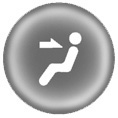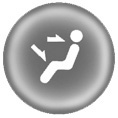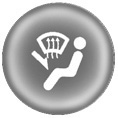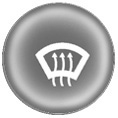 Hyundai Sonata: Mode selection
Hyundai Sonata: Mode selection

Type A
The mode selection button controls the direction of the air flow through the ventilation system.
The air flow outlet port is converted as follows:


Face-Level (B, D, E C, F)
Air flow is directed toward the upper body and face. Additionally, each outlet can be controlled to direct the air discharged from the outlet.

Bi-Level (B, D, E, C, F)
Air flow is directed towards the face and the floor.

Floor-Level (C, A, D, E)
Most of the air flow is directed to the floor, with a small amount of the air being directed to the windshield and side window defrosters.

Floor/Defrost-Level (A, C, D, E)
Most of the air flow is directed to the floor and the windshield with a small amount directed to the side window defrosters.

Defrost-Level (A, D)
Most of the air flow is directed to the windshield with a small amount of air directed to the side window defrosters.

Type B
If you push the button once, the corresponding switch will turn on, and if you push the button again, the switch will turn off.
 Defrost-Level (A,
D) (Button 1)
Defrost-Level (A,
D) (Button 1)
Most of the air flow is directed to the windshield.
 Face-Level (B, C,
D, E, F) (Button 2)
Face-Level (B, C,
D, E, F) (Button 2)
Air flow is directed toward the upper body and face.
Additionally, each outlet can be controlled to direct the air discharged from the outlet.
 Floor-Level (A, C,
D, E) (Button 3)
Floor-Level (A, C,
D, E) (Button 3)
Most of the air flow is directed to the floor.
Also you may select 2~3 modes at the same time for desired air flow.
 Defrost & Face Level (Button 1
and 2)
Defrost & Face Level (Button 1
and 2)
 Defrost & Floor Level (Button
1 and 3)
Defrost & Floor Level (Button
1 and 3)
 Face & Floor Level (Button 2 and
3)
Face & Floor Level (Button 2 and
3)
 All mode (Button 1, 2 and 3)
All mode (Button 1, 2 and 3)
 Heating and air conditioning
Heating and air conditioning
1. Start the engine.
2. Set the mode to the desired position. To improve the effectiveness of heating
and cooling :
- Heating:
- Cooling: 3. Set the temperature control to the desired position.
...
 MAX A/C-Level (B, D)
MAX A/C-Level (B, D)
To operate the MAX A/C, turn the temperature knob to extreme left. Air flow is
directed toward the upper body and face. In this mode, the air conditioning and
the recirculated air position wil ...
See also:
Canister Close Valve (CCV). Repair procedures
Inspection
1.
Turn the ignition switch OFF.
2.
Disconnect the CCV connector.
3.
Measure resistance between the ...
Repair procedures
Inspection
Lighting Switch Inspection
With the multifunction switch in each position, make sure that continuity
exists between the terminals below. If continuity is not as specified, replac ...
Instrument Cluster. Schematic Diagrams
Circuit Diagram
Input/Output Specification
...
